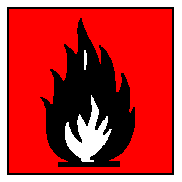International Chemical Safety Cards
| CARBON DISULFIDE | ICSC: 0022 |
CARBON DISULFIDE |
 |
 |
| TYPES OF HAZARD/ EXPOSURE |
ACUTE HAZARDS/ SYMPTOMS |
PREVENTION | FIRST AID/ FIRE FIGHTING |
| FIRE | Highly flammable. Many reactions
may cause fire or explosion. Gives off irritating or toxic fumes (or gases) in a fire. |
NO open flames, NO sparks, and
NO smoking. NO contact with hot surfaces. |
Powder, water spray, foam,
carbon dioxide. |
| EXPLOSION | Vapour/air mixtures are
explosive. |
Closed system, ventilation,
explosion-proof electrical equipment and lighting. Prevent build-up of electrostatic
charges (e.g., by grounding). Do NOT use compressed air for filling, discharging, or
handling. Do NOT expose to friction or shock. |
In case of fire: keep drums,
etc., cool by spraying with water. |
| EXPOSURE | |
STRICT HYGIENE! AVOID EXPOSURE
OF (PREGNANT) WOMEN! |
IN ALL CASES CONSULT A DOCTOR! |
| INHALATION | Confusion. Dizziness.
Drowsiness. Headache. Nausea. Shortness of breath. Vomiting. Weakness. Irritability.
Hallucination. |
Ventilation, local exhaust, or
breathing protection. |
Fresh air, rest. Artificial
respiration if indicated. Refer for medical attention. |
| SKIN | MAY BE ABSORBED! Dry skin.
Redness (Further see Inhalation). |
Protective gloves. Protective
clothing. |
First rinse with plenty of
water, then remove contaminated clothes and rinse again. Refer for medical attention. |
| EYES | Redness. Pain. |
Safety goggles, face shield, or
eye protection in combination with breathing protection. |
First rinse with plenty of water
for several minutes (remove contact lenses if easily possible), then take to a doctor. |
| INGESTION | (further see Inhalation). |
Do not eat, drink, or smoke
during work. |
Give nothing to drink. Refer for
medical attention. |
| SPILLAGE DISPOSAL | STORAGE | PACKAGING & LABELLING | ||
| Evacuate danger area! Consult an
expert! Eliminate ignition sources. Absorb remaining liquid in sand or inert absorbent and
remove to safe place. Do NOT wash away into sewer. Do NOT absorb in saw-dust or other
combustible absorbents (extra personal protection: complete protective clothing including
self-contained breathing apparatus). |
Fireproof. Separated from
oxidants, food and feedstuffs, combustible substances. Cool. Keep in the dark. Keep under
inert gas. |
Airtight. Unbreakable packaging;
put breakable packaging into closed unbreakable container. Do not transport with food and
feedstuffs. F symbol T symbol R: 11-36/38-48/23-62-63 S: 16-33-36/37-45 UN Hazard Class: 3 UN Subsidiary Risks: 6.1 UN Packing Group: I Marine pollutant. |
||
| SEE IMPORTANT INFORMATION ON BACK | ||||
|
||||